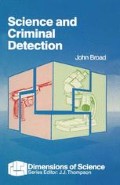Abstract
Trace evidence is invariably small in quantity and scanty in distribution. Frequently it is difficult to detect. It consists, principally, of fluids (usually in the form of stains) and discrete particles or fibres that a criminal leaves at, or takes from, the scene of a crime. Also marks — some of them very faint — are often left to indicate ‘suspicious circumstances’. One Founding Father of forensic science firmly maintained that
“every contact leaves a trace” — a sobering thought!
Preview
Unable to display preview. Download preview PDF.
Author information
Authors and Affiliations
Copyright information
© 1988 John Broad
About this chapter
Cite this chapter
Broad, J. (1988). Trace Evidence — the Body Fluids. In: Science and Criminal Detection. Dimensions of Science. Palgrave, London. https://doi.org/10.1007/978-1-349-10604-2_3
Download citation
DOI: https://doi.org/10.1007/978-1-349-10604-2_3
Publisher Name: Palgrave, London
Print ISBN: 978-0-333-48325-1
Online ISBN: 978-1-349-10604-2
eBook Packages: Palgrave Social & Cultural Studies CollectionSocial Sciences (R0)

